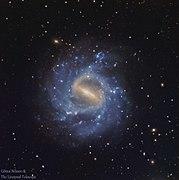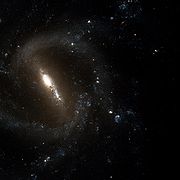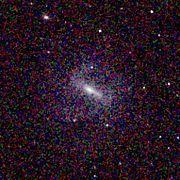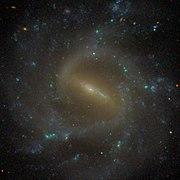| NGC 1073 | |
|---|---|
.tif.jpg) Hubble Space Telescope image of NGC 1073 Credit: ESA/Hubble & NASA. | |
| Observation data (J2000 epoch) | |
| Constellation | Cetus |
| Right ascension | 02h 43m 40.5s[1] |
| Declination | +01° 22′ 34″[1] |
| Redshift | 1208 ± 5 km/s[1] |
| Apparent magnitude (V) | 11.5[1] |
| Characteristics | |
| Type | SB(rs)c[1] |
| Apparent size (V) | 4′.9 × 4′.5[1] |
| Other designations | |
| UGC 2210,[1] PGC 10329[1] | |
NGC 1073 is a barred spiral galaxy in the constellation Cetus. The galaxy is estimated to be about 55 million light years from Earth, possess a disk spanning an estimated 80,000 light years in diameter, and likely contains a type of active core, called an HII nucleus.[2][3]
NGC 1073 is similar to the Milky Way only in their shared possession of a galactic bar. NGC 1073, however, does not possess the well-defined symmetrical arm structure the Milky Way exhibits, and retains a central bar larger than our home galaxy’s.[4] NGC 1073 can be viewed with a mid-sized telescope in rural, dark skies.
Gallery
RGB image of the galaxy NGC 1073. Data from the Liverpool Telescope, processed by Göran Nilsson. Total exposure time one hour.
NGC 1073 by 2MASS
NGC 1073 by the Sloan Digital Sky Survey
References
- ^ a b c d e f g h NED (February 25, 2007), Results for search on NGC 1073
- ^ Ho, Luis C.; Filippenko, Alexei V.; Sargent, Wallace L. W. (October 1997), "A Search for "Dwarf" Seyfert Nuclei. III. Spectroscopic Parameters and Properties of the Host Galaxies", Astrophysical Journal Supplement, 112 (2), pp. 315–390, arXiv:astro-ph/9704107, Bibcode:1997ApJS..112..315H, doi:10.1086/313041, S2CID 17086638
- ^ Staff (3 February 2012). "Hubble Telescope Spies Milky Way Galaxy's Twin". Space.com. Retrieved 3 February 2012.
- ^ National Radio Astronomy Observatory Milky Way
External links
- NGC 1073 on WikiSky: DSS2, SDSS, GALEX, IRAS, Hydrogen α, X-Ray, Astrophoto, Sky Map, Articles and images
- Video (01:18)



